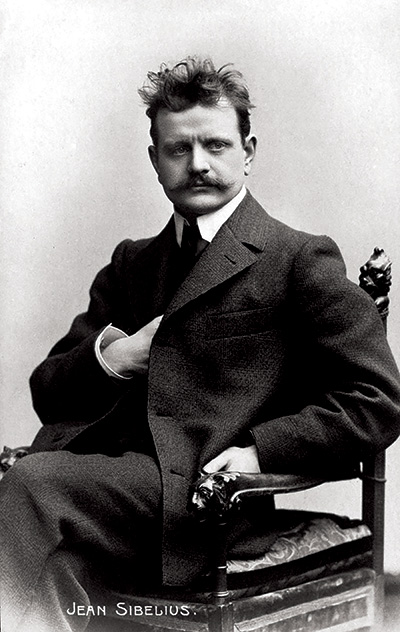Jean Sibelius

- Born: December 8, 1865 in Hämeenlinna, Finland
- Died: September 20, 1957 in Järvenpää, Finland
Valse Triste from the Incidental Music to Arvid Järnefelt’s Kuolema, Op. 44
- Composed: 1903; revised in 1905
- Premiere: December 2, 1903 in Helsinki, conducted by the composer
- Duration: approx. 6 minutes
Though Sibelius is universally recognized as the Finnish master of the symphony, tone poem and concerto, he also produced a large amount of music in the more intimate forms, including scores for eleven plays — the music to accompany a 1926 production of Shakespeare’s The Tempest was his last orchestral work. Early in 1903, Sibelius composed the music to underscore six scenes of a play by his brother-in-law, Arvid Järnefelt, titled Kuolema (“Death”). Sibelius conducted the small string orchestra (joined by bass drum and church bell in one number) behind the scenes at the drama’s premiere in Helsinki’s Finnish National Theater on December 2, 1903. The music included a piece accompanying the scene in which Paavali, the central character, is seen at the bedside of his dying mother. She tells him that she has dreamed of attending a ball. Paavali falls asleep, and Death enters to claim his victim. The mother mistakes Death for her deceased husband, and dances away with him. Paavali awakens to find her dead.
Sibelius gave little importance to this slight work, telling a biographer that “with all retouching [it] was finished in a week.” Two years later he arranged the music for solo piano and for chamber orchestra as Valse Triste (“Sad Waltz”), and sold it outright to his publisher, Fazer & Westerlund, for a tiny fee. The piece became immediately popular as a salon bonbon, and when the German firm of Breitkopf und Härtel acquired the rights to Sibelius’ music from Fazer & Westerlund late in 1905, they issued it in arrangements for all manner of performing forces, from solo flute to military band. The Valse Triste was the music by which Sibelius first became known in America (Rachmaninoff had experienced a similar instant notoriety because of his little C-sharp minor Prelude a decade earlier), and he conducted it on his first concert in the United States, at the Norfolk (Connecticut) Music Festival on June 4, 1914. It was among the most ubiquitous melodies in the years before World War I, but Sibelius, having sold away his rights, shared in none of its royalties.
Sibelius, like Brahms and Richard Strauss, was a great admirer of the waltzes of Johann Strauss. Sibelius’ biographer Cecil Gray claimed that he once spent an evening in a café with the composer, and was surprised at the constant stream of Viennese waltzes dispensed by the establishment’s orchestra. When he asked his companion why they were playing in the staid, old style rather than in the more fashionable jazz idiom, Sibelius smiled, and said, “That is because I am here; they play it because they know I love it.” Gray saw the Valse Triste as an “Hommage à Strauss,” and its success prompted Sibelius to add a Valse Romantique to the incidental music for a 1911 revival of Kuolema. Like the Viennese examples on which it is modeled, the Valse Triste comprises several continuous sections. It was the melancholy opening section that suggested the work’s name. This quiet, introspective paragraph is followed by a gossamer strain played with the utmost delicacy at the very tips of the string bows, a lyrical episode led by the woodwinds, and a more vigorous section for the full ensemble before the wistful mood of the opening returns briefly to round out this lovely, haunting miniature.